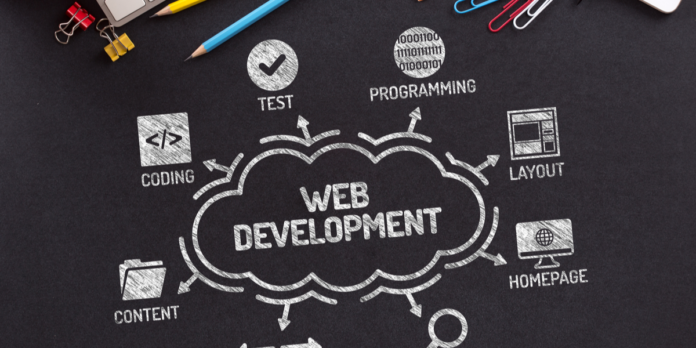Table of Contents
What is the life cycle of web development?
The Web Development Life Cycle. The life-cycle of a website development project is actually a detailed and systematic process that begins with a concept, idea, innovation, conceptualization, planning, implementation, evaluation, and finally the realization of the new Web presence. There are many frameworks, techniques, tools, and even languages involved in this life-cycle. Let us discuss web development life-cycle stages in one by one; it is important to understand trends in the web development life cycle. It will help us understand what are the things that happen in each of the stages mentioned in this article.
The 1st stage of web developing: the Concept
The web development life cycle begins with the Concept. Here the designers will brainstorm on the different possible ways to express the idea of the company and what the potential clients will be looking for. This is where the brainstorming takes place and the different methodologies that are used by the designers will be discussed.
During the concept phase, the goal of the web design company is to define the general theme that will help guide the creation of the actual product. During this stage, the company may decide whether or not to launch the product online or to start selling it directly to the market. If a company chooses to sell directly to the market then they are in essence launching their new product without having to deal with the process of incorporating their ideas into the target audience’s minds.
When the designers are done with their discussion they will start the implementation stage. In the middle of the web development life cycle, the application or the creation of the website itself takes place. This is also known as the beginning of web designing.
The 2nd stage of web developing: The Web Design and Development Process
The Web Design and Development Process: This is the second stage in the web development life cycle. Here the designers are trying to define the look and feel of the website, which is being developed; and it is during the design stage where the different sketches of the site are made and the wireframe process is done. After the wireframe is done, the actual design and development process starts. During the design stages, the different visualizations and mock-ups are doing to explore what the clients want and what the possible outcomes should be. Once the client approves the wireframe, the actual implementation of the website will start.
At this point the web application is known as a ‘skin’ or ‘behavior’ or ‘interface.’ This concept is very important to the web developer as it determines how a user will interact with a specific piece of web-developed applications.
The 3rd stage: The “Proofing”
Once a basic idea has been created, the next step in the web development life cycle occurs. This is known as the ‘proofing stage.’ During the proofing stage, the web application will be thoroughly tested to ensure that it is functioning properly and is meeting the developer’s expectations. This is also the point at which the web development company can suggest any changes that may need to be made. The web developer will use the feedback from the testers to further polish the final product.
The 4th stage: Developing of the Content
After the web application has been ‘proofed,’ it is time to move onto the ‘content development’ stage. During this stage, the content of the web design will be ‘redone’ using different methods and different approaches. The final product will be used to ‘live’ online; this means that visitors to the website will be able to access it. At this point, the web development life cycle may end with the web designing company discontinuing their services and the web application being offered to the public. However, this is not always the case as many companies choose to continue developing and offering web development products after they have been terminated.
The Web Development Life Cycle
Web applications or websites are developed and then they are deployed to the World Wide Web. The deployment will be a seamless process and the web app will be integrated into the corporate system. This will make it easier for the end users to use the web app. During the development stages, the web app will undergo several stages like the specification, the wireframe, the migration, integration to the business logic, and so on. Web developers also use a lot of tools during the web development life cycle for things like usability testing and bug-fixes.
The Web Application Development Life Cycle
During the development process, the wireframe is made to represent the overall appearance of the website app. The wireframe will be used for testing purposes, to check how the web app will look like when the website is fully developed and released to the end-users. After the wireframe is ready, the application team will start with the application development team, who will be working on the functionality and usability of the application.
Web Application Development
Web application development means developing applications that run on the World Wide Web. These applications include websites, e-commerce applications, client-side GUI’s, and mobile web applications. Some of the famous companies developing web applications include Google, Yahoo, Microsoft, Amazon, Cisco, PayPal, Sun Microsystems, and many more. Web designing can be done either manually or using sophisticated software.
The Web Design Life Cycle
Similar to the web application development process, the web design life cycle does not have a fixed duration. It depends on the business requirements and the preference of the owner of the company that is developing the software. The basic steps in the web design life cycle include the conceptualizing stage, the wireframing stage, the content development stage, the application development stage, and the testing stage. There are certain processes that are involved in each of these stages. They differ from one web application to another.
TeamWork is the Key to Successfully Completed Project
In order to have successful software development and web development projects, the entire team that is involved in the project must stay focused and dedicated. This team will spend a lot of time working together on every aspect of the software-developed applications. They will develop each component of the application together to create an efficient and effective system. The focus that they will have on meeting deadlines will enable them to complete software development in less time than what would be possible if each of the team members assigned to the project worked on their own separate projects. They will work together effectively because they have decided ahead of time how each of their tasks will be completed. In addition to being cohesive, each team member will also know what each of the other team members does, which allows them to efficiently complete their own tasks.
Each of the team members should be very passionate about their jobs. There is going to be a lot of pressure placed on each of them to complete software development promptly. It may seem like the pressure is not real, but it is very real. The developers need to be able to trust the people that are responsible for their job. If the web developers and software developers are not able to trust one another, it will make the development process last longer and take more time than what should have been done.
To Sum up
The software developed application goes through several phases during the development process. During the software development life cycle, the program will undergo a variety of testing procedures. These procedures will test for bugs and performance issues. The programmer will also be required to perform a large number of tests that will measure the functionality of the web application. All of these factors will play a large role in determining the final product. When the software developed application is released into the market it will become part of the target audience’s memories and they will be able to interact with it on a daily basis.
The complete life cycle of software development can take four to six months to complete. During this time a large team of developers will work on the project. The team will be made up of many different professionals such as designers, software engineers, and programmers. It will also include support staff such as marketing managers and support staff. When the software development team is working on web-developed applications they will constantly be under a large amount of pressure to meet deadlines.
The article was written by a content writer at https://writemypaper4me.org/












